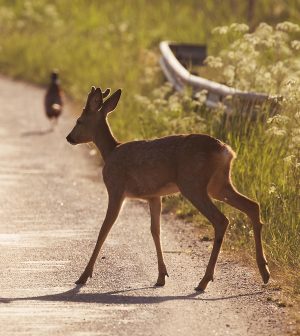- Navigating Your Midlife Crisis: Embracing New Possibilities
- City Raccoons Showing Signs of Domestication
- Mapping the Exposome: Science Broadens Focus to Environmental Disease Triggers
- One Week Less on Social Media Linked to Better Mental Health
- Your Brain Changes in Stages as You Age, Study Finds
- Some Suicide Victims Show No Typical Warning Signs, Study Finds
- ByHeart Formula Faces Lawsuits After Babies Sickened With Botulism
- Switch to Vegan Diet Could Cut Your Greenhouse Gas Emissions in Half
- Regular Bedtime Does Wonders for Blood Pressure
- Dining Alone Could Mean Worse Nutrition for Seniors
COVID Virus Is Evolving Three Times Faster in Deer Versus Humans

COVID-19 variants are evolving three times faster in white-tailed deer than in humans, according to a new study.
Deer serve as virus reservoirs, places where a virus thrives and multiplies, making them the perfect host for ongoing mutation.
The virus also appears to be passing between humans and deer, where genomic analysis showed at least 30 infections in deer were introduced by humans. How this jump is happening remains a mystery to experts.
“We generally talk about interspecies transmission as a rare event, but this wasn’t a huge sampling, and we’re able to document 30 spillovers. It seems to be moving between people and animals quite easily,” said co-senior author Andrew Bowman. He is an associate professor of veterinary preventive medicine at The Ohio State University in Columbus.
Scientists studied this by collecting more than 1,500 nasal swabs from free-ranging deer in 83 of Ohio’s 88 counties between November 2021 and March 2022.
More than 10% of the samples were positive for the COVID-19 virus. Scientists found at least one positive case in 59% of the counties in which testing took place.
“And the evidence is growing that humans can get it from deer — which isn’t radically surprising. It’s probably not a one-way pipeline,” Bowman said in a university news release.
The virus’ circulation in deer could lead to its spread to other wildlife and livestock.
Bowman and colleagues have been studying this and previously reported finding infections in white-tailed deer in nine Ohio locations at the end of 2021.
“We expanded across Ohio to see if this was a localized problem — and we find it in lots of places, so it’s not just a localized event,” Bowman said. “Some of the thought back then was that maybe it’s just in urban deer because they’re in closer contact with people. But in rural parts of the state, we’re finding plenty of positive deer.”
The study also detected COVID antibodies in blood samples from previous infections. The researchers estimated that about 23.5% of deer in Ohio had been infected at one time or another.
Scientists collected 80 whole-genome sequences in the samples that represented groups of viral variants. They also found the well-known Delta and Alpha variants.
The genetic composition of Delta variants in deer matched dominant lineages found in humans at the time. The authors said this pointed to spillover events, and that deer-to-deer transmission followed in clusters, some spanning multiple counties.
“There’s probably a timing component to what we found — we were near the end of a Delta peak in humans, and then we see a lot of Delta in deer,” Bowman said. “But we were well past the last Alpha detection in humans. So the idea that deer are holding onto lineages that have since gone extinct in humans is something we were worried about.”
Vaccination is likely to help people prevent severe disease if COVID-19 spillover from deer happens, the findings suggest. The study authors noted that vaccinated Siberian hamsters did not get as sick from infection from deer variants as unvaccinated.
Variants circulating in deer are expected to continue to change.
“Not only are deer getting infected with and maintaining SARS-CoV-2, but the rate of change is accelerated in deer — potentially away from what has infected humans,” Bowman said.
Thus far, no substantial outbreaks of deer-origin strains have occurred in humans, even with 30 million free-ranging deer in the United States.
But it’s highly likely the virus will continue to circulate in the animals, as 70% of Ohio deer have not yet been infected, according to the report.
“Having that animal host in play creates things we need to watch out for,” Bowman said. “If this trajectory continues for years and we have a virus that becomes deer-adapted, then does that become the pathway into other animal hosts, wildlife or domestic? We just don’t know.”
The study was published Aug. 28 in Nature Communications.
This work was supported by the U.S. National Institute of Allergy and Infectious Diseases and Ohio State’s Infectious Diseases Institute.
More information
The U.S. Centers for Disease Control and Prevention has more on spillover of COVID-19 variants between animals and people.
SOURCE: Ohio State University, news release, Aug. 28, 2023
Source: HealthDay
Copyright © 2025 HealthDay. All rights reserved.










